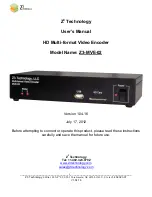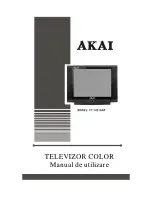
NAD
5
GB
lead to connect to the left and right ‘Audio Input’ of the
Power amp or processor to the Pre Out connectors.
Connect the left and right ‘Audio Output’ of the Pre-
amp or processor to the Main In connectors.
Note: The Pre-Out output signal will be affected by
the NAD-712’s volume and tone control settings.
10. NAD-LINK IN, OUT
The NAD-Link connector is used to pass com-
mands from the remote control to and from other
units fitted with NAD-Link connectors. This allows
centralised control of a complete system or gives sys-
tem control from more than one room. To function
with other units, connect the NAD-712’s NAD-Link
OUT to the NAD-Link IN on the other unit. NAD-Link
connectors can be daisy-chained, IN to OUT, so that
a whole system can be controlled from the remote
control facilities of one unit.
A single NAD-Link connection from a hi-fi system in
a second room will allow remote control of Multi
Room systems.
11. SPEAKERS A AND B
Speaker A terminals are the amplifier outputs for
the speakers located in the main listening room.
Speaker B terminals are the outputs for a second
set of speakers, normally located in another room
such as a dining room or kitchen.
Connect the right speaker to the terminals marked
‘R +’ and ‘R–’ ensuring that the ‘R+’ is connected to
the ‘+’ terminal on your loudspeaker and the ‘R–’ is
connected to the loudspeaker’s ‘–’ terminal.
Connect the terminals marked ‘L+’ and ‘L–’ to the
left speaker in the same way.
Always use heavy duty (16 gauge or thicker) strand-
ed wire to connect loudspeakers to your NAD-712.
The high-current binding post terminals can be
used as a screw terminal for cables terminating in
spade or pin connectors or for cables with bare wire
ends (See fig. 3).
SPADE CONNECTORS These should be slotted
under the terminal’s screw bushing, which is then fully
tightened. Ensure the connector is tightly secured and
there is no danger of bare metal from spade connec-
tors touching the back panel or another connector, as
this may cause damage.
BARE WIRES AND PIN CONNECTORS are wires
and pin connectors and should be inserted into the
hole in the shaft of the terminal. Unscrew the speaker
terminal’s plastic bushing until the hole in the screw
shaft is revealed. Insert the pin or bare cable end into
the hole and secure the cable by tightening down the
terminal’s bushing.
Avoid any danger of bare metal from the speaker
cables touching the back panel or another connector.
Ensure that there is only 1/2” (1cm) of bare cable or
pin and no loose strands of speaker wire.
12. SOFT CLIPPING
When an amplifier is driven beyond its specified
power output, a hard distorted sound can be heard on
very loud sounds. This is caused by the amplifier cut-
ting off or ‘hard clipping’ the peaks of sound that it
was not designed to reproduce. The NAD Soft
Clipping circuit gently limits the output of the system
to minimize audible distortion if the amplifier is over-
driven.
If your listening involves moderate power levels you
may leave the Soft Clipping switch to Off. If you are
likely to play at high levels, that could stretch the
amplifier’s power capability, then switch Soft Clipping
On.
13. IMPEDANCE SWITCH
Set the Impedance Switch to 4
when the receiver
is being used with two pairs of speakers (Speakers A
& B), or a single pair of speakers with a rated
impedance of 6
or less.
Set the Impedance Switch to 8
when the receiver
is being used with a single pair of speakers, which
have a rated impedance of more than 6 .
14. AC POWER CORD
After you have completed all connections to the
amplifier, plug the AC line cord into a “live” wall sock-
et or into a heavy-duty extension cord.
15. AC OUTLETS (ONLY IN 120V MODEL)
The AC power line cords of other stereo compo-
nents may be plugged into these accessory outlets.
The SWITCHED outlet is intended for all-electronic
products (e.g. an equalizer or other signal processor),
and will be switched on and off by the 712’s main
Power button.
The UNSWITCHED outlet should be used to pro-
vide power to products whose operation is
mechanical (e.g. a turntable, CD player, tape deck, or
VCR); such products should be switched on and off
with their own power switches. The UNSWITCHED
outlet can also be used to power a device containing
a clock timer, such as a VCR, or a digital tuner that
requires uninterrupted AC power to maintain station
tuning information stored in its memory.
FRONT PANEL CONTROLS
POWER, SPEAKERS AND HEADPHONE
FUNCTIONS.
1. POWER
Pressing the POWER switch turns the unit On and
the display and volume control LED will illuminate.
Pressing the POWER switch again will turn the
receiver Off.
The NAD-712 uses non-volatile memory to store
preset station information for the tuner, so that these
are not lost when the unit is switched off.
When the NAD-712 is switched On, pressing the
Standby button on the remote handset will put the
NAD-712 into Standby mode. The green Standby
indicator shows that power is being supplied to
the NAD-712, but the system is currently in the
Standby Mode.






































